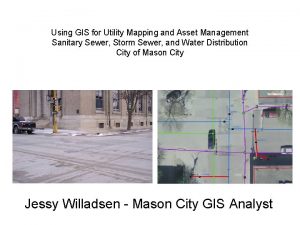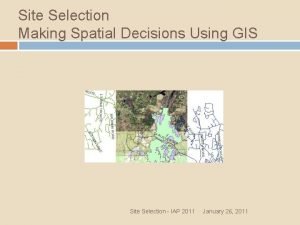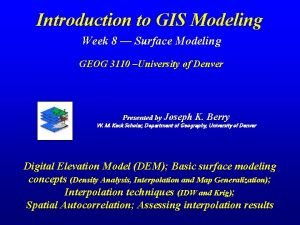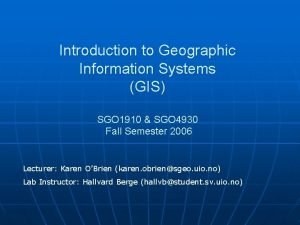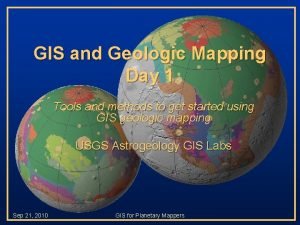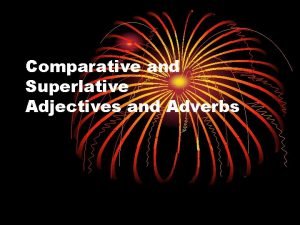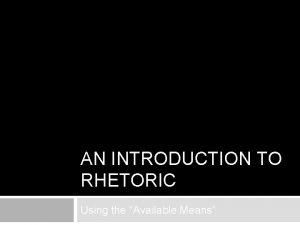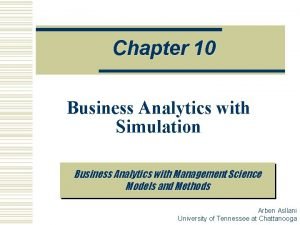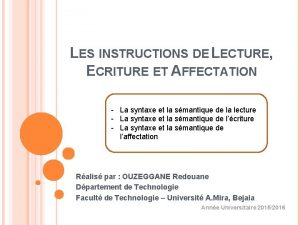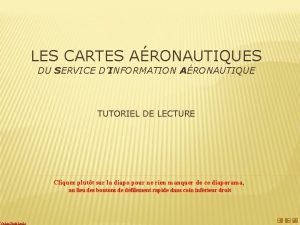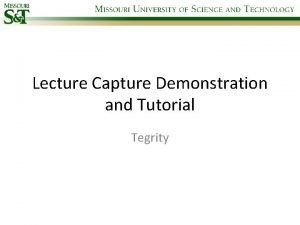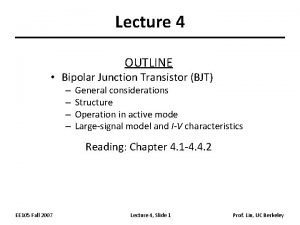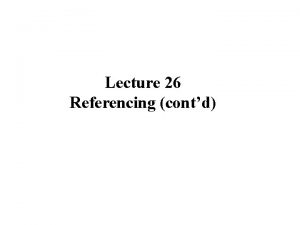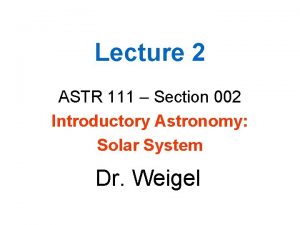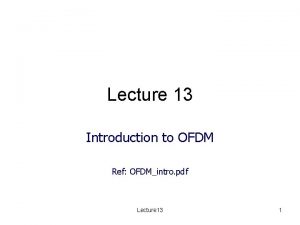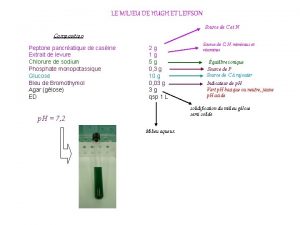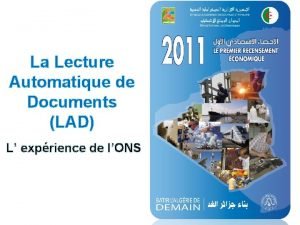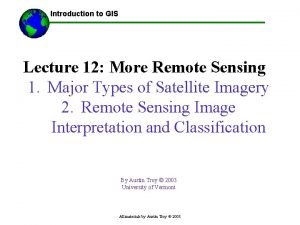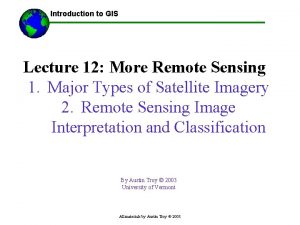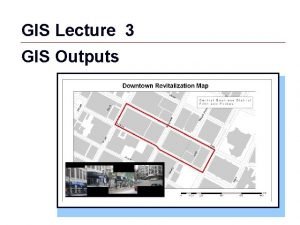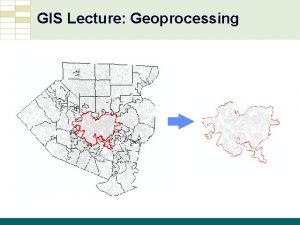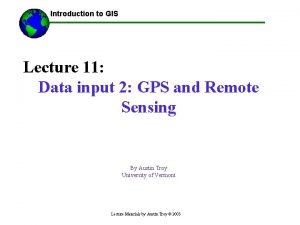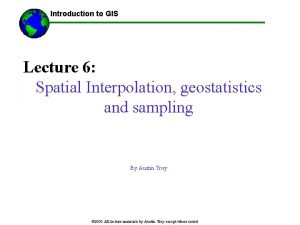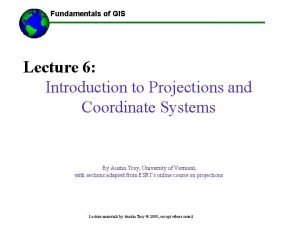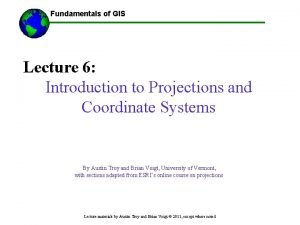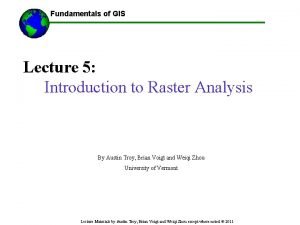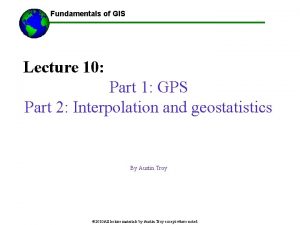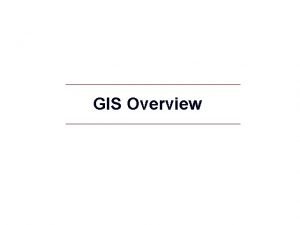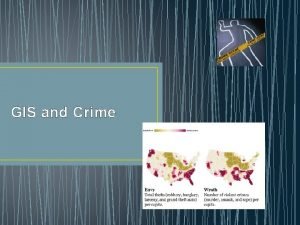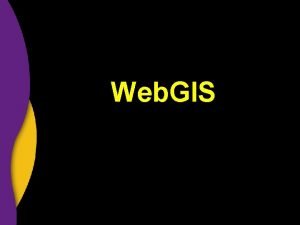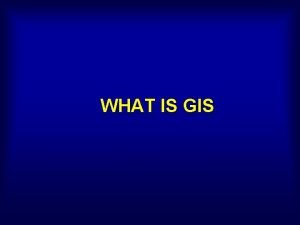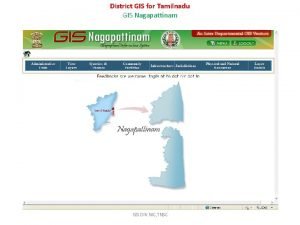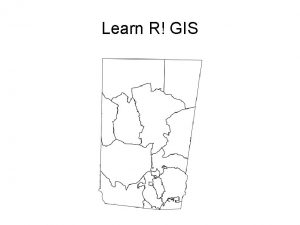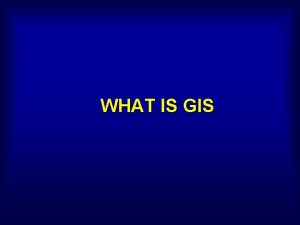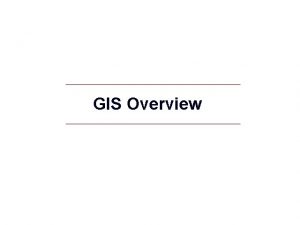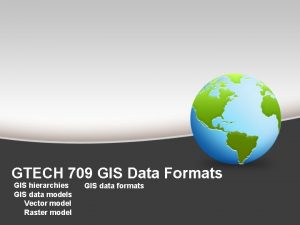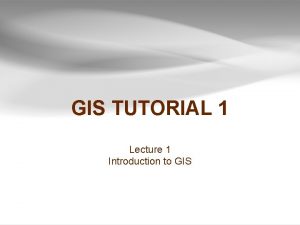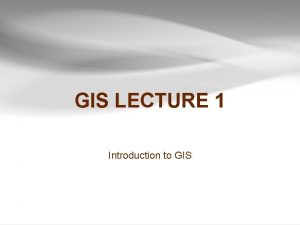Using GIS Introduction to GIS Lecture 12 More












































































- Slides: 76

------Using GIS-- Introduction to GIS Lecture 12: More Remote Sensing 1. Major Types of Satellite Imagery 2. Remote Sensing Image Interpretation and Classification By Austin Troy © 2003 University of Vermont All materials by Austin Troy except where noted © 2006

Introduction to GIS ------Using GIS-- Part 1: Major types of satellite imagery All materials by Austin Troy except where noted © 2006

Introduction to GIS Major satellite imagery products • SPOT • Landsat TM • Landsat MSS • IKONOS All materials by Austin Troy except where noted © 2006

Introduction to GIS Orbits • These RS satellites are in sun-synchronous orbit • The satellite passes over the same part of the Earth at roughly the same local time each day • Its “inclination” is about 8 degrees off of polar orbit • The fact that the earth is not perfect sphere makes the orbital plane rotate slowly around the earth (this would not happen if it were perfectly polar) All materials by Austin Troy except where noted © 2006

Introduction to GIS Orbits Source: http: //ltpwww. gsfc. nasa. gov/IAS/handbook/handbo ok_htmls/chapter 6. html All materials by Austin Troy except where noted © 2006

Introduction to GIS Orbits • The slow motion of that orbital plane matches the latitudinal motion of the sun in the sky over the year • Maintains similar sun angles along its ground trace for all orbits • That means that the area the sun flies over always get the same sunlight angle, which gives constant lighting All materials by Austin Troy except where noted © 2006 Source: http: //hdsn. eoc. nasda. go. jp/experience/rm_kiso/sat ellit_type_orbit_e. html

Introduction to GIS Scanners • Pushbroom (along track) vs. Whiskbroom (across track) • SPOT and IKONOS: Pushbroom • Landsat: Whiskbroom • Pushbroom scanners generally have higher radiometric resolution because they have longer “dwell time” than across-track scanners, which move laterally across landscape as also move forward Source: http: //www. sci-ctr. edu. sg/ssc/publication/remotesense/spot. htm All materials by Austin Troy except where noted © 2006

Introduction to GIS SPOT • Launched by France • Stands for Satellite Pour l'Observation de la Terre • Operated by the French Space Agency, Centre National d'Etudes Spatiales (CNES). • 5 versions—latest launched in 2002 All materials by Austin Troy except where noted © 2006

Introduction to GIS SPOT • The position of each HRV unit can be changed by ground control to observe a region of interest that is at an oblique angle to the satellite—up to ± 27º relative to the vertical. • Off-nadir viewing allows for acquisition of stereoscopic imagery (because of the parallax created) and provides a shorter revisit interval of 1 to 3 days. Source: http: //www. sci-ctr. edu. sg/ssc/publication/remotesense/spot. htm All materials by Austin Troy except where noted © 2006

Introduction to GIS SPOT • Oblique viewing capacity allows it to image any area within a 900 kilometer swath; can be used to increase the viewing frequency for a given point during a given cycle. The frequency varies with latitude: at the equator, a given area can be imaged 7 times during the same 26 -day orbital cycle. At latitude 45 degrees, a given area can be imaged 11 times during the orbital cycle, i. e. 157 times yearly and an average of 2. 4 days, with an interval ranging from a maximum of 4 days to a minimum of 1 day. • Any point on 95% of the earth may be imaged any day by one of the three satellites. Source: http: //www. spot. com/home/system/introsat/acquisi/ welcome. htm All materials by Austin Troy except where noted © 2006

Introduction to GIS SPOT • Two modes: panchromatic and multispectral • Panchromatic: single spectral band, corresponding to the visible part of the EM spectrum without the blue, from 0. 51 to 0. 73 µm. Single channel imaging mode, so yields black and white images. Resolution is 10 m. Pixels per line is 6000. Good for fine geometrical detail. • Multispectral mode: three spectral bands are XS 1 covering 0. 50 to 0. 59 µm (green), XS 2 covering 0. 61 to 0. 68 µ m (red) and XS 3 covering 0. 79 to 0. 89 µm (near infrared). Resolution is 20 m. Pixels per line is 3000. All materials by Austin Troy except where noted © 2006

Introduction to GIS SPOT • Some examples: mosaic false color tiles of Australia All materials by Austin Troy except where noted © 2006

Introduction to GIS SPOT All materials by Austin Troy except where noted © 2006

Introduction to GIS SPOT • SPOT can be purchased online using a browser to select your area and product http: //www. spot. com/HOME/PROSER/USASelect_On. Line/usa_select_on-line. htm All materials by Austin Troy except where noted © 2006

Introduction to GIS LANDSAT • first started by NASA in 1972 but later turned over to NOAA • Since 1984 satellite operation and data handling are managed by a commercial company EOSAT Source: http: //www. sci-ctr. edu. sg/ssc/publication/remotesense/landsat. htm All materials by Austin Troy except where noted © 2006

Introduction to GIS LANDSAT • LANDSAT-1 launched 1972 and lasted until 1978. • LANDSAT-2 launched 1975 • Three more satellites were launched in 1978, 1982, and 1984 (LANDSAT-3, 4, and 5 respectively). • LANDSAT-6 was launched on October 1993 but the satellite failed to obtain orbit. • LANDSAT-7 launched in 1999 but had malfunction in 2003 • Only 5 is correctly operating All materials by Austin Troy except where noted © 2006

Introduction to GIS LANDSAT • Its repeat cycle is about 16 days and always crosses equator at around 10 AM. • Orbit takes about 99 minutes (14. 5 per day) • Distance between ground tracks of consecutive orbits is 2752 km at equator because of the earth’s rotation • By following earth’s rotation with each pass, it can keep crossing the equator at the same time All materials by Austin Troy except where noted © 2006

Introduction to GIS LANDSAT • Swath is 183 km wide, although that includes overlap, since data frame is 170 km • 233 orbits, for each 16 day cycle Source: http: //eosims. cr. usgs. gov: 5725/DATASET_DOCS/landsat 7_dataset. html All materials by Austin Troy except where noted © 2006

Introduction to GIS LANDSAT • Scenes are then indexed by the path and a row Source: http: //eosims. cr. usgs. gov: 5725/DATASET_DOCS/landsat 7_dataset. html All materials by Austin Troy except where noted © 2006

Introduction to GIS LANDSAT • LANDSAT 4 and 5 had two types of sensors, MSS (multi-spectral scanner) and TM (thematic mapper): • MSS: Started on LANDSAT 1, terminated in late 1992. 80 m resolution with four spectral bands from the visible green to the near-infrared (IR) wavelengths. Only Landsat 3’s MSS sensor had a fifth band in thermal-IR. All materials by Austin Troy except where noted © 2006

Introduction to GIS LANDSAT 4 and 5 MSS: • TM: * Mid infra red * * All materials by Austin Troy except where noted © 2006

Introduction to GIS LANDSAT MSS • MSS has a square instantaneous field of view (IFOV), with an 11. 56 ° field of view. Source: http: //edcwww. cr. usgs. gov/glis/hyper/guide/landsat All materials by Austin Troy except where noted © 2006

Introduction to GIS LANDSAT TM: applications Band Nominal Spectral location applications 1 Blue Water body penetration, soil-water discrimination, forest type mapping, cultural feature ID 2 Green reflectance peak of veg, for veg ID and assessment of vigor, cultural feature ID 3 Red Chlorophyll absorption region, plant species differentiation, cultural feature ID 4 Near infra red Veg types, vigor and biomass content, dilineating water bodies, soil moisture assessment 5 mid infra red (1. 551. 75 mm) Veg moisture, soil moisture, diff of soil from clouds 6 Thermal infra red Veg stress analysis, soil moisture, thermal mapping 7 mid infra red(2. 08 -2. 35 Discriminating mineral and rock types, veg moisture mm) All materials by Austin Troy except where noted © 2006

Introduction to GIS LANDSAT TM • An example: August 14, 1999 (left) and October 17, 1999 (right) images of the Salt Lake City area • differences in color due to growing season All materials by Austin Troy except where noted © 2006

Introduction to GIS LANDSAT 7 • Spatial resolution of bands Band wavelength spectrums are slightly different from LANDSAT 5 All materials by Austin Troy except where noted © 2006

Introduction to GIS LANDSAT 7 • LANDSAT 7 has an excellent mission coverage archive Source: http: //ltpwww. gsfc. nasa. gov/IAS/handbook_htmls/chapter 6. html All materials by Austin Troy except where noted © 2006

Introduction to GIS LANDSAT Imagery All materials by Austin Troy except where noted © 2006

Introduction to GIS LANDSAT Imagery Composite of shortwave infrared, Near-Infrared and Red. Shows manmade features as well as densely forested areas and agricultural lands All materials by Austin Troy except where noted © 2006

Introduction to GIS LANDSAT Imagery Same bands: shows wetlands, urban, open water, forest All materials by Austin Troy except where noted © 2006

Introduction to GIS LANDSAT Imagery Same bands: light yellow-green color represents northern hardwood forest. The dark green patches represent various conifer species All materials by Austin Troy except where noted © 2006

Introduction to GIS IKONOS data • High resolution satellite developed by Space Imaging, launched 1999 • Has sun-synchronous orbit and crosses equator at 10: 30 AM • Ground track repeats every 11 days • Highly maneuverable: can point at a new target and stabilize itself in seconds, enabling it to follow meandering features • The entire spacecraft moves, not just the sensors All materials by Austin Troy except where noted © 2006

Introduction to GIS IKONOS data • Can collect data at angles of up to 45° from the along track and across track axes • This allows for side by side and fore and aft stereoscopic imaging • At its nadir it has 11 km swath width • 11 km by 11 km image size, but user specified strips and mosaics can be ordered • Employs a linear array scanner All materials by Austin Troy except where noted © 2006

Introduction to GIS IKONOS data • IKONOS collects panchromatic band (. 45 to. 90 mm) at 1 m resolution • Collects four multispectral bands at 4 m resolution • Bands include blue (. 45 to. 52 mm) , green (. 51 to. 60 mm) , red (. 63 to. 70 mm), near IR (. 76 to. 85 mm) • Radiometric resolution is 11 bits, or 2048 values All materials by Austin Troy except where noted © 2006

Introduction to GIS IKONOS data • Here is 1 m IKONOS view of suburbs, near winter Olympics All materials by Austin Troy except where noted © 2006 Source: spaceimaging. com

Introduction to GIS IKONOS data • 1 m IKONOS view of Dubai All materials by Austin Troy except where noted © 2006 Source: spaceimaging. com

Introduction to GIS IKONOS data • 1 m IKONOS pan image of Rome Source: spaceimaging. com All materials by Austin Troy except where noted © 2006

Introduction to GIS IKONOS data • 1 m image of “Survivor” camp in Africa Source: spaceimaging. com All materials by Austin Troy except where noted © 2006

Introduction to GIS ------Using GIS-- Part 2: Remote Sensing Image Processing and Interpretation All materials by Austin Troy except where noted © 2006

Introduction to GIS Image Pre-Processing • Once an image is acquired it is generally processed to eliminate errors • Two categories: • Geometric correction • Radiometric correction All materials by Austin Troy except where noted © 2006

Introduction to GIS Image classification • This is the science of turning RS data into meaningful categories representing surface conditions or classes • Spectral pattern recognition procedures classifies a pixel based on its pattern of radiance measurements in each band: more common and easy to use • Spatial pattern recognition classifies a pixel based on its relationship to surrounding pixels: more complex and difficult to implement • Temporal pattern recognition: looks at changes in pixels over time to assist in feature recognition All materials by Austin Troy except where noted © 2006

Introduction to GIS Spectral Classification • Two types of classification: • Supervised: the analyst designates on-screen “training areas” known land cover type from which an interpretation key is created, describing the spectral attributes of each cover class. Statistical techniques are then used to assign pixel data to a cover class, based on what class its spectral pattern resembles. • Unsupervised: automated algorithms produce spectral classes based on natural groupings of multi-band reflectance values (rather than through designation of training areas), and the analyst uses references data, such as field measurements, DOQs or GIS data layers to assign areas to the given classes All materials by Austin Troy except where noted © 2006

Introduction to GIS Spectral Classification • Supervised: • Better for cases where validity of classification depends on a priori knowledge of the technician • Conventional cover classes are recognized in the scene from prior knowledge or other GIS/ imagery layers • Therefore selection of classes is pre-determined and supervised • Training sites are chosen for each of those classes • Each training site “class” results in a cloud of points in n dimensional “measurement space, ” representing variability of different pixels spectral signatures in that class All materials by Austin Troy except where noted © 2006

Introduction to GIS Spectral Classification • Supervised: Here a bunch of pre-chosen training sites of known cover type All materials by Austin Troy except where noted © 2006 Source: http: //mercator. upc. es/nicktutorial/Sect 1/nicktutor_1 -15. html

Introduction to GIS Spectral Classification • Supervised: • The next step is for the computer to assign each pixel to the spectral class is appears to belong to, based on the DN’s of its constituent bands • There are numerous algorithms the computer uses, including: • Minimum distance to means classification (Chain Method) • Gaussian Maximum likelihood classification • Parallelpiped classification All materials by Austin Troy except where noted © 2006

Introduction to GIS Spectral Classification • Supervised: • These algorithms look at “clouds” of pixels in spectral “measurement space” from training areas, and try to determine which “cloud” a given non-training pixel falls in. • The simplest method is “minimum distance” in which a theoretical center point of point cloud is plotted, based on mean values, and an unknown point is assigned to the nearest of these. That point is then assigned that cover class. • They get much more complex from there. All materials by Austin Troy except where noted © 2006

Introduction to GIS Spectral Classification • Supervised: • Examples of two classifiers All materials by Austin Troy except where noted © 2006 Source: http: //mercator. upc. es/nicktutorial/Sect 1/nicktutor_1 -16. html

Introduction to GIS Spectral Classification • Unsupervised: • Computer groups all pixels according to their spectral relationships and looks for natural spectral groupings of pixels, called spectral classes Spectral class 1 Spectral class 2 • Assumes that data in different cover class will not belong to same grouping • Once created, the analyst assesses their utility Source: F. F. Sabins, Jr. , 1987, Remote Sensing: Principles and Interpretation. All materials by Austin Troy except where noted © 2006

Introduction to GIS Spectral Classification • Unsupervised: • After comparing the reclassified image (based on spectral classes) to ground reference data, the analyst can determine which land cover type the spectral class corresponds to • Has advantage over supervised classification: the “classifier” identifies the distinct spectral classes, many of which would not have been apparent in supervised classification and, if there were many classes, would have been difficult to train all of them. Not required to make assumptions of what all the cover classes are before classification. • Clustering algorithms include: K-means, texture analysis All materials by Austin Troy except where noted © 2006

Introduction to GIS Spectral Classification • Unsupervised: • Here’s an example Source: http: //elwood. la. asu. edu/grsl/lter/fig 5. html All materials by Austin Troy except where noted © 2006

Introduction to GIS Spectral Classification • Unsupervised: Another example Source: http: //mercator. upc. es/nicktutorial/Sect 1/nicktutor_1 -14. html All materials by Austin Troy except where noted © 2006

Introduction to GIS Classifying Imagery • Spectral classification can be used for numerous purposes, like classifying geology, water temperature, soil moisture, other soil characteristics, water sediment load, water pollution levels, lake eutrophication, flood damage estimation, groundwater location, vegetative water stress, vegetative diseases and stresses, crop yields and health, biomass quantity, net primary productivity, forest vegetation species composition, forest fragmentation, forest age (in some cases), rangeland quality and type, urban mapping and vectorization of manmade structures • One of the most common applications of classification is land cover and land use mapping All materials by Austin Troy except where noted © 2006

Introduction to GIS Land Cover/ Land Use Mapping • Land cover refers to the feature present and land use refers to the human activity associated with a plot of land • The LU/LC classes to be derived will depend on the system being used. One of the most common is the USGS Anderson Classification System (Anderson et al. 1976). This classification scheme is hierarchical, with nine very general categories at Level I, and an increasing number of classes and detail and level increases. Paper available online at http: //landcover. usgs. gov/pdf/anderson. pdf • Anderson system intermixes land use and land cover metrics, by inferring land use from land cover. Unfortunately, land cover can only tell us a limited amount about land use—think of outdoor recreation as a land use. Need additional data for these classes. All materials by Austin Troy except where noted © 2006

Introduction to GIS Land Cover/ Land Use Mapping • Land use and land cover classification system for use with remote sensor data (Anderson et al. 1976) • Level II • 1 Urban or Built-up Land 11 Residential 12 Commercial and Services 13 Industrial 14 Transportation, Communications, and Utilities 15 Industrial and Commercial Complexes 16 Mixed Urban or Built-up Land 17 Other Urban or Built-up Land All materials by Austin Troy except where noted © 2006

Introduction to GIS • Level I Land Cover/ Land Use Mapping • 2 Agricultural Land Level II 21 Cropland Pasture 22 Orchards, Groves, Vineyards, Nurseries, and Ornamental Horticultural Areas 23 Confined Feeding Operations 24 Other Agricultural Land • 3 Rangeland 31 Herbaceous Rangeland 32 Shrub and Brush Rangeland 33 Mixed Rangeland • 4 Forest Land 41 Deciduous Forest Land 42 Evergreen Forest Land 43 Mixed Forest Land • 5 Water 51 Streams and Canals 52 Lakes 53 Reservoirs 54 Bays and Estuaries • 6 Wetland 61 Forested Wetland All materials by Austin Troy except where noted © 2006 62 Nonforested Wetland

Introduction to GIS Land Cover/ Land Use Mapping • Level II • 7 Barren Land 71 Dry Salt Flats. 72 Beaches 73 Sandy Areas other than Beaches 74 Bare Exposed Rock 75 Strip Mines Quarries, and Gravel Pits 76 Transitional Areas 77 Mixed Barren Land • 8 Tundra 81 Shrub and Brush Tundra 82 Herbaceous Tundra 83 Bare Ground Tundra 84 Wet Tundra 85 Mixed Tundra • 9 Perennial Snow or Ice 91 Perennial Snowfields 92 Glaciers All materials by Austin Troy except where noted © 2006

Introduction to GIS Land Cover/ Land Use Mapping • Level 3 and 4 categories deliver even more detail. • USGS only specifies classifications for 1 and 2. They suggest that higher level classification be designed by local planners who know the land uses, because of the narrowness of the categories • As an example for level 3, with “urban” (level 1) “residential” (level 2) category, includes single family home (111), multifamily home (112), group quarters (113), mobile home parks (115), etc. • LANDSAT data can be used to generate level 1 easily, level 2 with some finesse (15 to 20 m resolution recommended) • Levels 3 and 4, IKONOS data or aerial photographs are needed. Level 4 requires much supplemental information All materials by Austin Troy except where noted © 2006

Introduction to GIS Land Cover/ Land Use Mapping • Here is an example of LANDSAT data classified using the Anderson System All materials by Austin Troy except where noted © 2006

Introduction to GIS Accuracy Assessment • This is one of the most important parts of image classification. • Error rates can be very high in classification accuracies, especially with lower resolution data, and where pixels are mixed • This is often the most time consuming part of image classification • NLCD effort undertook effort to classify errors in each type of land cover, broken down by region of the US • User’s accuracy for type X: Percent of pixels classified as X that really are X. Producer’s accuracy: percent of pixels that were classified as other than X but really are X. All materials by Austin Troy except where noted © 2006

Introduction to GIS Accuracy Assessment: example Table 1 Accuracy Assessment of LULC classification Classified data Reference data Urban Forest Other Sum User Acc. % Urban 71 13 16 100 71 Forest 0 100 100 Other 2 10 88 100 88 Sum 73 123 104 300 Producer Acc. (%) 97. 3 81. 3 84. 6 Overall accuracy (%) All materials by Austin Troy except where noted © 2006 86. 3

Introduction to GIS Object-Oriented Classification Traditional classifiers don’t work as well for new generation of high resolution data, like this 2 foot Emerge Color infrared airphoto. Why? Meaningless to classify each pixel All materials by Austin Troy except where noted © 2006

Introduction to GIS Pixel-Based Classification A Slide by Jarlath O’Neil Dunne All materials by Austin Troy except where noted © 2006 B

Introduction to GIS Object-oriented classification Steps: • Segmentation of rasters into polygon objects • Objects are defined such that they minimize within-unit heterogeneity and maximize between unit heterogeneity, subject to some user defined parameters. • The user can control the scale parameter for acceptable level of heterogeneity. They can also control the degree to which segmentation is based on spectral or spatial characteristics, since heterogeneity is defined in terms of both. By repeating the segmentation with different scale parameters, the user can create a nested hierarchy of objects>>big objects containing smaller objects, containing smaller objects All materials by Austin Troy except where noted © 2006

Object-Oriented Classification B C Slide by Jarlath O’Neil Dunne All materials by Austin Troy except where noted © 2006

Introduction to GIS Object-oriented classification All materials by Austin Troy except where noted © 2006

Introduction to GIS Object-oriented classification All materials by Austin Troy except where noted © 2006

Introduction to GIS Object-oriented classification Steps: • Following segmentation, each object is encoded with information about its tone, shape, area, context, neighborhors and spectral characteristics (e. g. mean, standard deviation, max, min or each band’s spectral reflectance) • This information can be used for feature extraction in which objects’ properties are analyzed to look for characteristics that help to discriminate one object type from another. That is, what object information helps discriminate one from another? All materials by Austin Troy except where noted © 2006

Introduction to GIS Object-oriented classification All materials by Austin Troy except where noted © 2006

Introduction to GIS Object-oriented classification Steps: • Then objects are classified by either defining training areas of known cover type (known as supervised fuzzy classification) or creating class descriptions organized through inheritance-based rules into a knowledge base (known as fuzzy knowledge base classification). All materials by Austin Troy except where noted © 2006

Introduction to GIS Object-oriented classification Steps: • In the knowledge base approach, complex membership functions can be derived that describe characteristics that are typical or atypical for a certain class. The more a given object displays the characteristics, the more likely it is to be classified into the class to which those characteristics pertain. Characteristics can be based on spectral response summary statistics, shape characteristics, adjacency, connectivity, and overlay with certain thematic features. All materials by Austin Troy except where noted © 2006

Introduction to GIS Object-oriented classification All materials by Austin Troy except where noted © 2006

Introduction to GIS Object-oriented classification Steps • The classification can be hierarchical and nested, with finer classifications within coarser ones • Small classified objects can be aggregated up to large object classes and large objects can be split into smaller ones. Can then assign different segmentations to different class hierarchy level • Allows for high precision classifications within coarser, general classifications All materials by Austin Troy except where noted © 2006

Introduction to GIS Object-oriented classification Steps • The classification can be hierarchical and nested, with All materials by Austin Troy except where noted © 2006

All materials by Austin Troy except where noted © 2006

All materials by Austin Troy except where noted © 2006

Introduction to GIS Object-oriented classification Steps • Can use additional thematic layers to populate the knowledge base and create rules about what a certain class can be on top of, next to, or near. This can increase the accuracy of classifications, especially as you increase categorical precision and start getting into classifiying land uses in addition to land cover • Hence, when you do training areas, you not only get average spectral responses and shape metrics for a class, but also can get average values from underlying layers to help increase classification accuracy • Examples: farm fields as fn of slope, soils, etc; different suburban development types as function of distance to urban centers, income, crime, etc. All materials by Austin Troy except where noted © 2006

Introduction to GIS Object-oriented classification Software • e. Cognition: one of the top Object oriented classification software packages More info: see Ecognition website: http: //www. definiens-imaging. com/index. htm All materials by Austin Troy except where noted © 2006
 More more more i want more more more more we praise you
More more more i want more more more more we praise you More more more i want more more more more we praise you
More more more i want more more more more we praise you 01:640:244 lecture notes - lecture 15: plat, idah, farad
01:640:244 lecture notes - lecture 15: plat, idah, farad Utility mapping using gis
Utility mapping using gis Making spatial decisions using gis
Making spatial decisions using gis 5 apples in a basket riddle
5 apples in a basket riddle The more you study the more you learn
The more you study the more you learn Aspire not to have more but to be more
Aspire not to have more but to be more Newton's 1st law example
Newton's 1st law example Knowing more remembering more
Knowing more remembering more The more i give to thee the more i have
The more i give to thee the more i have More choices more chances
More choices more chances Human history becomes more and more a race
Human history becomes more and more a race Introduction to biochemistry lecture notes
Introduction to biochemistry lecture notes Introduction to psychology lecture
Introduction to psychology lecture Introduction to algorithms lecture notes
Introduction to algorithms lecture notes Introduction to gis
Introduction to gis Introduction to gis
Introduction to gis Gis
Gis Irregular adjectives
Irregular adjectives Using system.collections
Using system.collections Unit 25 special refrigeration system components
Unit 25 special refrigeration system components Cars model research introduction
Cars model research introduction Matlab u-net
Matlab u-net Introducing rhetoric using the available means
Introducing rhetoric using the available means Simulation in business analytics
Simulation in business analytics Intro paragraph layout
Intro paragraph layout Project procurement management lecture notes
Project procurement management lecture notes Lecture about sport
Lecture about sport Lecture on healthy lifestyle
Lecture on healthy lifestyle Whats nihilism
Whats nihilism Meaning of this
Meaning of this Randy pausch last lecture summary
Randy pausch last lecture summary Tensorflow lecture
Tensorflow lecture Theology proper lecture notes
Theology proper lecture notes Strategic management lecture
Strategic management lecture Geology lecture series
Geology lecture series Social psychology lecture
Social psychology lecture In text citation for a lecture
In text citation for a lecture Public sector management lecture notes
Public sector management lecture notes Project planning begins with the melding of
Project planning begins with the melding of Anchorage length eurocode
Anchorage length eurocode Electricity and magnetism lecture notes
Electricity and magnetism lecture notes Classical mechanics
Classical mechanics Physics 101 lecture notes pdf
Physics 101 lecture notes pdf Physical science lecture notes
Physical science lecture notes Power system dynamics and stability lecture notes
Power system dynamics and stability lecture notes Natural language processing nlp - theory lecture
Natural language processing nlp - theory lecture Microbial physiology and metabolism lecture notes
Microbial physiology and metabolism lecture notes Application of mechatronics ppt
Application of mechatronics ppt Ternology
Ternology Les objectifs de la lecture au primaire
Les objectifs de la lecture au primaire Instruction de lecture
Instruction de lecture Lecture carte aéronautique
Lecture carte aéronautique Lecture title
Lecture title Slidetodoc
Slidetodoc Financial engineering lecture notes
Financial engineering lecture notes Bjt
Bjt Software engineering lecture notes
Software engineering lecture notes Extension lecture meaning
Extension lecture meaning Chapitre 49 le dernier jour d'un condamné texte
Chapitre 49 le dernier jour d'un condamné texte Tegrity lecture capture
Tegrity lecture capture What are social letters
What are social letters Bjt current equation
Bjt current equation Harvard referencing lecture
Harvard referencing lecture How to write a recipe review
How to write a recipe review The parsec lecture tutorial answers
The parsec lecture tutorial answers Introduction to ofdm
Introduction to ofdm Basic semiconductor physics:
Basic semiconductor physics: Milieu citrate de simmons
Milieu citrate de simmons Land use planning lecture notes
Land use planning lecture notes Grille de lecture systémique
Grille de lecture systémique Travaux encadrés antigone
Travaux encadrés antigone Lecture pas à pas
Lecture pas à pas La lecture renoir
La lecture renoir Lecture automatique de document
Lecture automatique de document Lecture chorale définition
Lecture chorale définition



